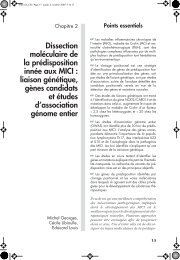The Role of the Bovine Growth Hormone Receptor and ... - Genetics
The Role of the Bovine Growth Hormone Receptor and ... - Genetics
The Role of the Bovine Growth Hormone Receptor and ... - Genetics
Create successful ePaper yourself
Turn your PDF publications into a flip-book with our unique Google optimized e-Paper software.
GHR <strong>and</strong> PRLR Genes in Milk Production 2163into <strong>the</strong> model markedly influenced estimates <strong>of</strong> marginalSNP effects. On <strong>the</strong> o<strong>the</strong>r h<strong>and</strong>, because <strong>of</strong> lowfrequencies <strong>of</strong> genotypes with <strong>the</strong> less frequent allele,we anticipate that in our family data <strong>the</strong> power <strong>of</strong>detecting interaction <strong>and</strong> proper partitioning betweenmarginal <strong>and</strong> interaction effects is very low.In our family data seven sires are heterozygous forPRLR S18N but <strong>the</strong> QTL effect is segregating in only two<strong>of</strong> <strong>the</strong>se families. In <strong>the</strong>se families <strong>the</strong> sires are heterozygousalso for <strong>the</strong> GHR F279Y <strong>and</strong> thus one explanationcould be that <strong>the</strong> second QTL acts only as a modifier <strong>of</strong><strong>the</strong> first QTL so is detectable only through a model withQTL interaction.<strong>The</strong> association <strong>of</strong> GHR F279Y <strong>and</strong> PRLR S18N polymorphismwith milk production traits was confirmed onan independent sample <strong>of</strong> progeny-tested bulls (dataset II) not included in <strong>the</strong> family data. <strong>The</strong> result clearlymimics <strong>the</strong> genetic effects observed in data set I: <strong>the</strong>effect <strong>of</strong> PRLR S18N (snp5) predominates on yield traits<strong>and</strong> that <strong>of</strong> GHR F279Y (snp1) on content traits. <strong>The</strong>model with interaction terms is selected as a best modelin most <strong>of</strong> <strong>the</strong> traits.Blott et al. (2003) concluded that it is unlikely that<strong>the</strong> F279Y or tightly associated polymorphism accountsfor <strong>the</strong> entire chromosome 20 QTL effect in <strong>the</strong>Holstein–Friesian population. We herein suggest thatPRLR S18N or a polymorphism in strong LD with PRLRS18N is partly responsible for <strong>the</strong> effect seen in milktraits in Finnish Ayrshire. However, we cannot exclude<strong>the</strong> possibility that also additional loci are involved inchromosome 20 QTL effect.In this study <strong>the</strong> main focus is on <strong>the</strong> coding region<strong>of</strong> GHR <strong>and</strong> PRLR. In both cases <strong>the</strong> coding sequenceis only a minor part <strong>of</strong> <strong>the</strong> 80- to 100-kb gene, <strong>and</strong><strong>the</strong>refore <strong>the</strong> majority <strong>of</strong> <strong>the</strong> sequence remains unanalyzed.If <strong>the</strong> genomic orientation <strong>of</strong> bovine GHR <strong>and</strong>PRLR genes corresponds to <strong>the</strong> orientation <strong>of</strong> <strong>the</strong>human <strong>and</strong> mouse genes, <strong>the</strong>n it is possible that in <strong>the</strong>bovine genome <strong>the</strong> 59-untranslated regions <strong>of</strong> GHR <strong>and</strong>PRLR are facing on opposite str<strong>and</strong>s, at 7 Mb distancefrom each o<strong>the</strong>r. <strong>The</strong> 59 regulatory region <strong>of</strong> GHR islarge (.30 kb). For example, in bovine GHR threealternative promoters with untranslated exons have beenwell characterized (Hauser et al. 1990; Heap et al. 1996;Lucy et al. 1998; Jiang et al. 1999) <strong>and</strong> <strong>the</strong> existence <strong>of</strong>six o<strong>the</strong>r variants has been suggested (Jiang <strong>and</strong> Lucy2001). In this study we have sequenced <strong>the</strong> three wellcharacterizedpromoters <strong>of</strong> GHR without finding anysequence polymorphism in Finnish Ayrshire. Even though<strong>the</strong> majority <strong>of</strong> <strong>the</strong> GHR <strong>and</strong> PRLR sequences still needto be analyzed it is possible that o<strong>the</strong>r genes are atleast partly responsible for <strong>the</strong> effect. In <strong>the</strong> human genomicsequence <strong>the</strong>re are still tens <strong>of</strong> genes betweenGHR <strong>and</strong> PRLR, some with known <strong>and</strong> some withunknown functions.An interesting fact pointed out by Blott et al. (2003)is that <strong>the</strong> administration <strong>of</strong> growth hormone in lactatingcows affects mainly protein yield. <strong>The</strong> F279Y mutationis associated with milk yield, protein percentage,<strong>and</strong> fat percentage in Finnish Ayrshire but not withprotein yield. An association between yield traits <strong>and</strong>PRLR S18N was, however, observed. Both GH <strong>and</strong> PRLare essential hormonal factors regulating <strong>the</strong> development<strong>and</strong> differentiation <strong>of</strong> functional mammary gl<strong>and</strong>(reviewed by Kelly et al. 2002). <strong>The</strong> genes encodingPRL <strong>and</strong> GH have evolved from a common ancestralgene <strong>and</strong> <strong>the</strong>ir receptors (PRLR, GHR) are also closelyrelated. <strong>The</strong>se multifunctional hormones <strong>and</strong> <strong>the</strong>irreceptors have numerous actions <strong>and</strong> very complicatedregulation. Even though GH <strong>and</strong> PRL have clear <strong>and</strong>distinct hormonal functions <strong>the</strong>re appears to be extensiveoverlap in many respects (reviewed by Bole-Feysotet al. 1998 <strong>and</strong> Frank 2001). Interesting features make ittempting to speculate about <strong>the</strong> potential role <strong>of</strong> GH<strong>and</strong>/or PRL receptors in <strong>the</strong> observed associations.In <strong>the</strong> mammary gl<strong>and</strong>, PRL is <strong>the</strong> hormone primarilyresponsible for <strong>the</strong> syn<strong>the</strong>sis <strong>of</strong> milk proteins, lactose,<strong>and</strong> lipids, all major components <strong>of</strong> milk (see Bole-Feysot et al. 1998). This could <strong>of</strong>fer an explanation for<strong>the</strong> observed association with yield. <strong>The</strong> osmotic nature<strong>of</strong> milk lactose on <strong>the</strong> o<strong>the</strong>r h<strong>and</strong> <strong>of</strong>fers a temptingexplanation for <strong>the</strong> effect on milk yield <strong>and</strong> percentagetraits, because <strong>the</strong> percentage traits might reflect <strong>the</strong>amount <strong>of</strong> water in milk as <strong>the</strong> increase in milk watercontent decreases <strong>the</strong> proportion <strong>of</strong> milk solids. This is<strong>of</strong> course highly speculative.We herein report new evidence that <strong>the</strong> QTL effectson milk production traits on chromosome 20 in a FinnishAyrshire population can be explained by variation intwo distinct genes, GHR <strong>and</strong> PRLR. <strong>The</strong> result <strong>of</strong> ourmultimarker regression analysis suggests that in FinnishAyrshire two QTL segregate on <strong>the</strong> chromosomal regionincluding GHR <strong>and</strong> PRLR. Two substitutions showed anassociation with milk production traits: <strong>the</strong> previouslyreported F-to-Y substitution in <strong>the</strong> transmembrane domain<strong>of</strong> GHR <strong>and</strong> an S-to-N substitution at position 18 in<strong>the</strong> signal peptide <strong>of</strong> PRLR. <strong>The</strong> results provide strongevidence that <strong>the</strong> effect <strong>of</strong> PRLR S18N substitution isdistinct from <strong>the</strong> GHR F279Y effect. In particular, GHRF279Y has <strong>the</strong> highest influence on protein percentage<strong>and</strong> fat percentage while PRLR S18N markedly influencesprotein <strong>and</strong> fat yield. In addition, association analysissuggests interaction between <strong>the</strong>se two substitutions.We herein suggest that <strong>the</strong> observed substitutions areei<strong>the</strong>r directly responsible for <strong>the</strong> QTL effect or tightlyassociated with causal mutation.This work was funded by <strong>the</strong> Ministry <strong>of</strong> Agriculture <strong>and</strong> Forestry <strong>of</strong>Finl<strong>and</strong> (grant 5100/39/98), <strong>the</strong> European Union (grant BIO4-98-0471), <strong>and</strong> <strong>the</strong> Finnish Animal Breeding Association.LITERATURE CITEDArranz, J.-J., W. Coppieters, P.Berzi, N.Cambisano, B.Grisartet al., 1998 A QTL affecting milk yield <strong>and</strong> composition maps



